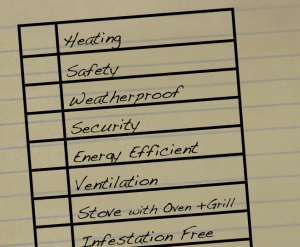Tenancy Quality Standards
Tenancy Quality Standards

Why do Tasmanian Residential Tenants Need Quality Standards?
Tasmania presently has the worst legislation for rental standards in Australia. In fact, there are no standards under the Residential Tenancy Act 1997. Some say that renting a property is just like any other contract but we think:
- that shelter is a basic need that requires extra protection. It is a base from which we conduct the rest of our lives. If you don’t buy that then…
- people are being forced to take substandard housing that 10 or so years ago would have remained vacant when vacancy rates were considerably higher. Vacancy rates are low in most of Tasmania and the market is not creating enough housing to keep up with demand. If the free-marketeer in you is still not convinced, then…
- landlords have little incentive to improve their houses in situations where the tenant pays the bills (eg heating). This is known as the problem of split incentives. But if you still think that market forces will compensate the tenant in this situation through lower rent…
- most tenancies are entered into in the warmer months and at that point landlords know far more about the condition of the housing in terms of heating and weatherproofing than tenants. Economists call this the market failure of asymmetrical information.
How will this affect investment in housing in Tasmania?
First may we say that every person deserves to live in decent shelter and that it is up to everyone to ensure that there are enough resources to make that happen. Second, we think that investment will not be adversely affected anyway. Tenancy Quality Standards will not be as high as those in the Building Code that regulates new housing, so there will be no direct impact on the supply of new housing. For existing rental housing some properties will require modifications and that will require investment (therefore investment increases). A possible effect could be that some landlords (including Housing Tasmania) may have money tied up in renovations that otherwise may been used to increase housing supply – but if the demand is there for new housing, then landlords should be able to borrow for it.
How will this affect rents in Tasmania?
There are two schools of thought about the impact of minimum standards upon rent:
1. That rents are set based on supply and demand independent of the cost of housing – this would mean that there would be little change from the imposition of Tenancy Quality Standards, or
2. That costs of compliance with the Tenancy Quality Standards will increase rents. If this is the case, often the increase in rent will be offset by the savings in bills. For example, a free standing heater uses up to 47.15c per hour, whereas a heat pump uses 17.77c per hour.
Minimum Housing Standards in Other Jurisdictions
Australia
At present no state or territory has prescribed minimum standards, although there are moves to institute them:
ACT: The Greens are about to table the Residential Tenancies (Minimum Housing Standards) Amendment Bill. This model proposes that rental properties should have a 2 star energy rating by 2013 and a 3 star rating by 2015, along with security and water efficiency standards. (New dwellings in the ACT need to be 6 star and in Tasmania 5 star). For info and a link to the ACT discussion paper click here.
Victoria: The Greens member, Greg Barber introduced a private members bill in 2009 that would give the Housing Minister the power to set minimum housing standards for rental properties and rooming houses. The bill lapsed earlier this year.
International
Ireland: New Regulations for rental properties require heating, clothes washing facilities and clothes drying facilities where there is no place to hang your clothes out!
Alberta, Canada: Alberta is a bit colder than Tasmania but we think their Minimum Housing and Health Standards are a good base from which Tasmania can work from.
UK: The Better Homes Standard applies to public housing (the equivalent of Housing Tasmania and community housing).
The criteria for the standard are as follows:
- it must meet the current statutory minimum standard for housing
- it must be in a reasonable state of repair
- it must have reasonably modern facilities and services
- it must provide a reasonable degree of thermal comfort.
The Tenants’ Union Opinion
The Tenants’ Union is open to suggestions about what should be included as minimum Tenancy Quality Standards but we like the Minimum Housing and Health Standards of Alberta, Canada with some amendments:
- Housing premises are structurally sound, in a safe condition, in good repair, and maintained in waterproof, windproof and weatherproof condition.
- Equipment and Furnishings – Occupants of housing premises must be supplied with adequate; sanitary facilities, heat, potable water, utilities and space for sleeping.
- The owner shall ensure that all rooms and other areas are provided in a clean and sanitary condition.
For the full list of the Tenancy Quality Standards we propose, click here.


